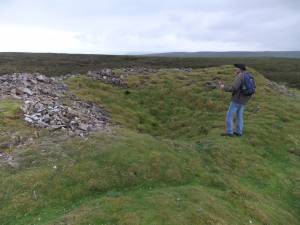|
| *****SWAAG_ID***** | 882 |
| Date Entered | 22/07/2015 |
| Updated on | 24/07/2015 |
| Recorded by | Tim Laurie |
| Category | Mining Related |
| Record Type | Mining |
| SWAAG Site Name | |
| Site Type | |
| Site Name | |
| Site Description | |
| Site Access | Public Access Land |
| Record Date | 20/07/2015 |
| Location | Satron Moor and Beazy Hill |
| Civil Parish | Grinton |
| Brit. National Grid | SD 946 946 |
| Altitude | 530m |
| Geology | Faulted Little and Red Beds mineralised limestones and cherts high above Oxnop Scar worked from shallow shafts on the line of the Satron Tarn String, the Simon Grooves String and the Beazy String. The shallow shaft mounds are visible as islands of calcareous grass within a pathless blanket peat moorland and water filled peat gutters.
This Mining ground is described in detail in: Dunham and Wilson 1985: British Geological Survey Memoirs: 'Geology of the North Pennine Orefield.Volume 2. Stainmore to Craven, Chapter 11, pp167-170. HMSO. |
| Record Name | Lead mining remains on Satron Moor: Satron Tarn String, the Simon Grooves String and the Beazy String. |
| Record Description | These extensive lead mine operations are today visible as isolated shallow shaft mounds within an area of deep blanket peat. More concentrated mining remains are to be seen at Beazy Hill. Despite searching, no galena was visible in the dressing floors and the mine debris here was generally limonitised limestone with brown partly oxidised carbonate enclosing cerussite crystal-coated galena characteristic of flots. (Dunham and Wilson, 1985 p.167.) |
| Dimensions | |
| Geographical area | |
| Species | |
| Scientific Name | |
| Common / Notable Species | |
| Tree and / or Stem Girth | |
| Tree: Position / Form / Status | |
| Tree Site ID | 0 |
| Associated Site SWAAG ID | 0 |
| Additional Notes | The brown mineral in photos 2 an3 below could be the brown mineral which BGS Memoir mentions 'limonitised limestone with brown, partly oxidised carbonate enclosing cerussite-coated crystals of galena' and also the presence of 'an unusual dense massive goethite on the Beazy String which Raistrick 1975 p.85 ascribes to replacement of massive iron carbonate,...or from oxidisation of pyrite.' |
| Image 1 ID | 6286 Click image to enlarge |
| Image 1 Description | Isolated shaft mound within blanket peat |  |
| Image 2 ID | 6287 Click image to enlarge |
| Image 2 Description | The brown lead ore found at Beazy String is probably that described by Raistrick 1975, p.85 and in the BGS Memoir as: 'partly oxidised carbonate enclosing cerussite-coated crystals of galena' as seen at Simon Grooves' |  |
| Image 3 ID | 6288 Click image to enlarge |
| Image 3 Description | The lead ore as seen at Beazy String |  |
| Image 4 ID | 6289 Click image to enlarge |
| Image 4 Description | Wax Cap toadstool on mine debris. |  |
| Image 5 ID | 6290 Click image to enlarge |
| Image 5 Description | Water filled peat gutter despite the summer drought. |  |
| Image 6 ID | 6291 Click image to enlarge |
| Image 6 Description | Distant glimpse of Summerlodge Tarn, |  |
| Image 7 ID | 6292 Click image to enlarge |
| Image 7 Description | Shaft Mound on Simon Grooves. |  |
| Image 8 ID | 6293 Click image to enlarge |
| Image 8 Description | Bright lichen in mine debris, |  |
| Image 9 ID | 6294 Click image to enlarge |
| Image 9 Description | Compound coral fossilised in limestone. |  |
| Image 10 ID | 6296 Click image to enlarge |
| Image 10 Description | Beware! Recently collapsed peat in-filled mine shaft. |  |
| Image 11 ID | 6297 |
| Image 11 Description | Moss vegetation on the mine debris |  |
| Image 12 ID | 6299 |
| Image 12 Description | THe head of Beazy Hill lead mine area |  |
| Image 13 ID | 6301 |
| Image 13 Description | Scurvy grass (Cochlearia offinalis), a common metalophyte on lead mine debris. |  |
| Image 14 ID | 6303 |
| Image 14 Description | Round leaved sundew (Drosera rotundifolia) on wet peat |  |
| Image 15 ID | 6304 |
| Image 15 Description | Mine shaft, the uppermost of three isolated shafts on Beazy string. |  |














